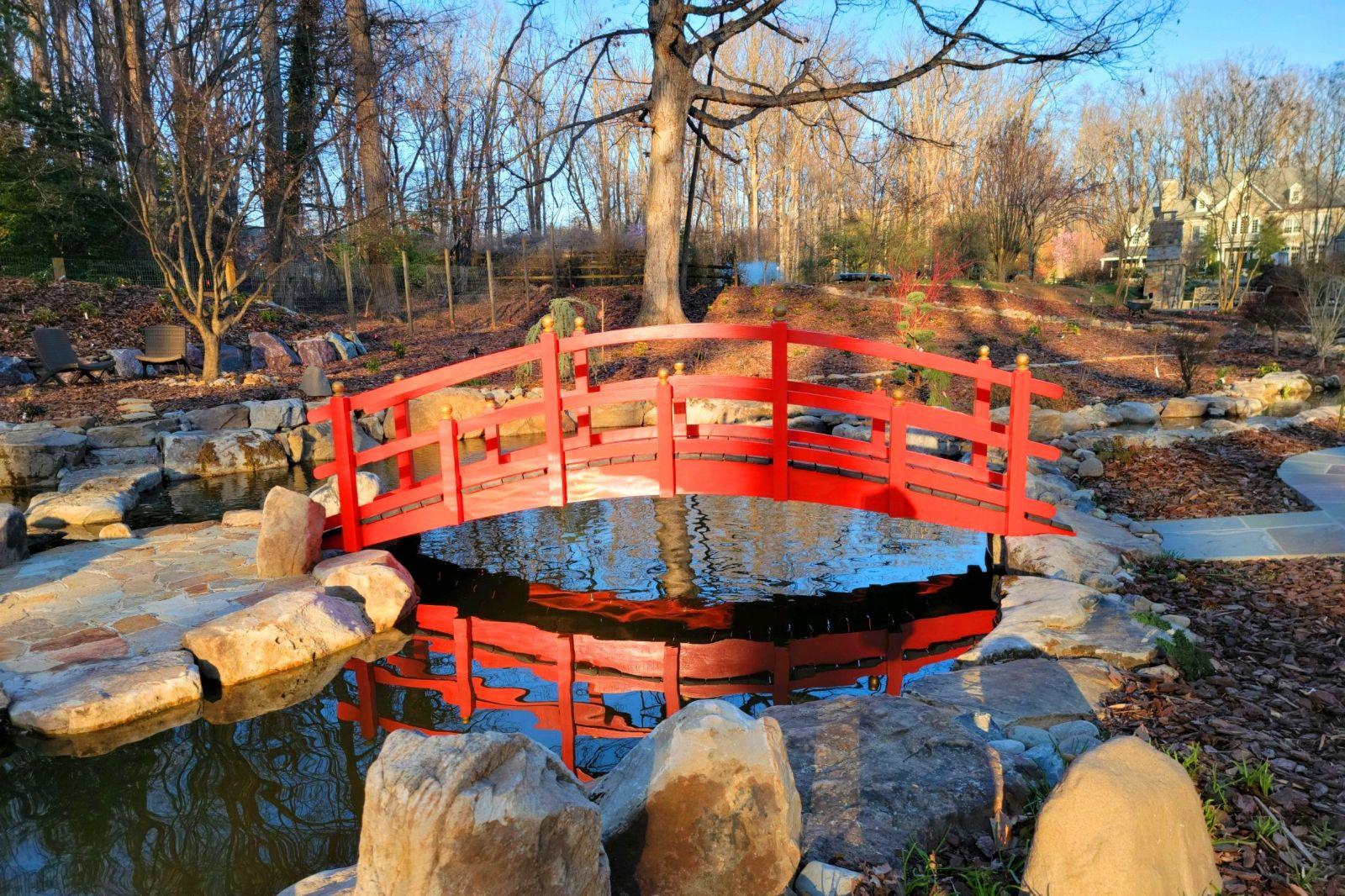Garden Bridges Made from Redwood: Design, Construction, and Benefits

Garden bridges are elegant and functional structures that can transform a landscape, blending natural beauty with architectural charm. These bridges, often designed to span small streams, ponds, or other landscape features, offer a unique way to connect different areas of a garden or park. When built with Redwood, especially from California, garden bridges gain additional durability and aesthetic appeal. Redwood is particularly well-suited for this purpose due to its natural resistance to decay and its stunning appearance, making it a popular choice in garden bridge construction. This article explores the design, construction, purpose, and benefits of garden bridges made from California Redwood.
What is a Garden Bridge?
A garden bridge is a small, decorative bridge, typically built over water features such as ponds, streams, or small ravines, within a garden or park. These bridges serve both practical and aesthetic purposes. They allow easy passage over obstacles like water bodies, but they also contribute significantly to the beauty of the garden, creating a focal point and enhancing the overall landscape design.
Why Redwood from California?
Redwood trees, particularly those native to California, are famous for their large size, straight grain, and rich color. The wood from these trees is highly prized for various construction purposes, including the making of garden bridges. California Redwoods are some of the tallest and oldest trees in the world, and their wood possesses several desirable qualities:
- Durability: Redwood is known for its resistance to decay, insects, and rot. This makes it perfect for outdoor applications like garden bridges, where exposure to the elements can cause other types of wood to deteriorate more quickly.
- Aesthetic Appeal: The reddish-brown hue of redwood adds a warm, natural touch to any garden. The texture of the wood, with its fine grain, makes it visually appealing in both rustic and modern designs.
- Lightweight: Despite being strong and durable, redwood is relatively lightweight, which makes it easier to handle during construction and reduces the structural load.
- Sustainability: While the environmental impact of using wood from any tree species is a concern, redwood is often sourced from sustainably managed forests, which helps to mitigate deforestation concerns.
Designing a Garden Bridge with Redwood
The design process of a garden bridge made from redwood involves several steps, each tailored to the specific needs of the space and the intended purpose of the bridge. Key factors to consider during the design process include:
1. Size and Scale
The first step in designing a garden bridge is determining the size and scale relative to the surrounding landscape. A bridge that is too large can dominate the space, while one that is too small may not provide the visual or functional impact desired. The bridge should be proportional to the garden or water feature it spans. Most garden bridges are between 4 to 10 feet in length, but this can vary based on the space and the features involved.
2. Style and Aesthetic
The style of the bridge should complement the overall design of the garden. Common styles for garden bridges include:
- Arched Bridges: These have a classic, graceful design that evokes the image of a traditional Japanese garden bridge. Arched bridges are ideal for creating visual interest and are often seen in more formal garden settings.
- Flat Bridges: These bridges have a more modern, minimalistic style and are typically used when the emphasis is on function or a more contemporary garden design.
- Suspension Bridges: In larger gardens, suspension-style bridges can add a dramatic effect, though they may require additional support structures.
3. Structural Considerations
Despite being lightweight, redwood needs to be properly supported, especially when spanning a body of water. The structural design must account for the weight load of the bridge and the forces of nature, including wind and rain. A well-designed garden bridge will incorporate proper foundation support, typically using treated posts or piers placed securely in the ground or into the waterbed, depending on the design.
4. Railing and Safety Features
Safety features, such as railings, are a critical component of the design, particularly if the bridge is intended to be used by children or the elderly. The height and design of the railings will vary based on the intended use of the bridge and local building codes. Redwood railings are often designed to match the bridge’s aesthetic and can range from simple balustrades to more intricate, decorative designs.
5. Materials and Finishes
Aside from the redwood for the frame and decking, other materials may be required for the bridge’s construction, such as steel for reinforcements or stone for the foundations. Additionally, finishing materials such as stains, oils, or sealants are essential to protect the redwood from the elements. A finish will help preserve the natural beauty of the wood while extending its lifespan by preventing damage from moisture, UV rays, and insects.
Building a Garden Bridge
The process of constructing a garden bridge made from redwood generally involves the following steps:
1. Preparing the Site
Before construction begins, the site needs to be prepared. This includes clearing the area, digging foundations or post holes, and ensuring the ground is level and stable. If the bridge is spanning a body of water, it may also require the installation of pilings or other underwater supports.
2. Building the Framework
The next step is to construct the framework of the bridge. This involves creating the base structure, which will consist of beams and supports made of redwood. The beams are placed and secured at the correct height, ensuring the bridge is level and stable.
3. Decking and Railings
Once the framework is in place, the decking is installed. Redwood planks are typically used for the deck, providing a smooth and safe walking surface. Railings are then added, ensuring that the bridge is safe and secure for use.
4. Finishing Touches
The final step in building the garden bridge is to apply finishes to the wood, such as a protective sealant or stain. This helps to protect the redwood from the elements, preserving its beauty and extending its lifespan. The bridge can also be painted or stained to match the surrounding garden or landscape.
Purpose and Uses of Garden Bridges
Garden bridges have a range of practical and aesthetic purposes. These include:
- Enhancing Landscape Aesthetics: A well-placed garden bridge can become a focal point in the landscape, drawing attention to a specific area of the garden or a water feature.
- Connecting Garden Spaces: Garden bridges are often used to create a physical connection between different areas of a garden or park, especially in landscapes that have ponds, streams, or other obstacles.
- Promoting Tranquility: In many cultures, bridges are symbolic of transitions or journeys. Garden bridges, especially those in serene environments, are designed to create a peaceful atmosphere where visitors can reflect and relax.
- Providing Functional Passage: Of course, the most practical purpose of a garden bridge is to allow passage over water or uneven ground, providing a safe and easy route through the garden.
- Supporting Wildlife Habitats: In some cases, garden bridges are designed to promote biodiversity, providing a space for plants to grow along the edges or a crossing point for small wildlife.
Benefits of Garden Bridges Made from Redwood
Garden bridges made from redwood offer numerous benefits, both practical and aesthetic:
- Durability and Longevity: Redwood’s natural resistance to rot, decay, and insect damage makes it a long-lasting material for outdoor use.
- Low Maintenance: Redwood garden bridges require minimal upkeep compared to other types of wood. Regular cleaning and occasional resealing are usually enough to maintain their appearance.
- Eco-Friendly: Sourced from sustainably managed forests, redwood is a more environmentally friendly option compared to other materials like treated lumber, which may contain harmful chemicals.
- Versatility in Design: Redwood’s rich color and fine grain allow for a wide range of design options, from traditional to modern, making it suitable for any garden style.
- Increased Property Value: A well-designed garden bridge can add significant aesthetic value to a property, increasing its appeal and market value, especially if it is located in a picturesque setting.
Conclusion
Garden bridges made from California Redwood are not only functional but also serve as beautiful additions to any landscape. Their durability, aesthetic appeal, and versatility make them a popular choice for garden designers and homeowners alike. By understanding the design principles, construction methods, and benefits of these bridges, it’s clear that they are more than just decorative structures – they are lasting, sustainable enhancements to our natural environments. More information about garden bridges you may find on this website – www.redwoodgardenbridges.com
Recent Posts
- The Timeless Allure of Kundan Jewellery: A Symbol of Royal Elegance
- What is a Capacitive Switch and How It Works?
- Top Services Offered by an Artificial Intelligence Automation Agency
- How Can AI-Powered Inbound Call Centers Improve Customer Satisfaction?
- Understanding Your Customers: The Power of Market Research
Recent Comments

Understanding Your Customers: The Power of Market Research

Role Of Oven Toaster Grillers In Meal Prepping For Busy Professionals

Which Is the Best Shipping Option from the USA to India: Sea or Air?

How to Blend Home & Gym Workouts: A Balanced Routine for Everyone from Reddit Users

Why Skill-Based Games Are Gaining Popularity in India

Learn How to Play Tez Rummy – Simple Guide for Complete Beginners

Unlocking the Volleyball Betting Hack Sportsbooks Want Hidden: Strategies for Success
